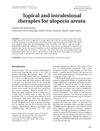Non-Endocrine Alopecia in Dogs and Cats: Conditions, Treatments, and Prognoses
July 2019

TLDR The document concludes that non-endocrine alopecia in pets varies in treatment effectiveness and often has a poor prognosis, especially in cats.
The document from 2019 provides an overview of non-endocrine alopecia in dogs and cats, discussing conditions, treatments, and prognoses. In dogs, it covers conditions like post-clipping alopecia and Alopecia X, with treatments ranging from none to medications like melatonin, and varying prognoses from self-resolving to life-long. In cats, it discusses conditions such as feline psychogenic alopecia, with treatments like environmental enrichment, and highlights the resistance to treatment, especially in cases linked to neoplasia. The prognosis for non-endocrine alopecia in cats is often poor, with many being euthanized within 8 weeks of symptom onset. Diagnostic methods include exams, biopsies, and trichograms, and the document notes that many alopecias are cosmetic, with a common relapse after treatment.



